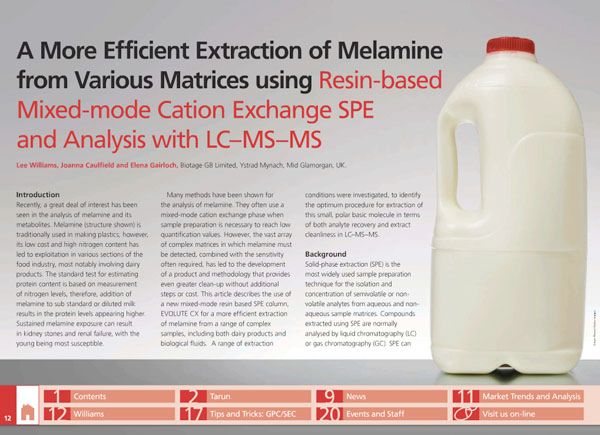A More Efficient Extraction of Melamine from Various Matrices using Resin-based Mixed-mode Cation Exchange SPE and Analysis with LC–MS–MS
More on melamine extraction in dairy and biological samples.
Recently, a great deal of interest has been seen in the analysis of melamine and its metabolites. Melamine (structure shown) is traditionally used in making plastics; however, its low cost and high nitrogen content has led to exploitation in various sections of the food industry, most notably involving dairy products. The standard test for estimating protein content is based on measurement of nitrogen levels, therefore, addition of melamine to sub standard or diluted milk results in the protein levels appearing higher. Sustained melamine exposure can result in kidney stones and renal failure, with the young being most susceptible.Many methods have been shown for the analysis of melamine. They often use a mixed-mode cation exchange phase when sample preparation is necessary to reach low quantification values. However, the vast array of complex matrices in which melamine must be detected, combined with the sensitivityoften required, has led to the development of a product and methodology that provides even greater clean-up without additional steps or cost. This article describes the use of a new mixed-mode resin based SPE column, EVOLUTE CX for a more efficient extraction of melamine from a range of complex samples, including both dairy products and biological fluids. A range of extraction conditions were investigated, to identify the optimum procedure for extraction of this small, polar basic molecule in terms of both analyte recovery and extract cleanliness in LC–MS–MS.
Accelerating Monoclonal Antibody Quality Control: The Role of LC–MS in Upstream Bioprocessing
This study highlights the promising potential of LC–MS as a powerful tool for mAb quality control within the context of upstream processing.
Using GC-MS to Measure Improvement Efforts to TNT-Contaminated Soil
April 29th 2025Researchers developing a plant microbial consortium that can repair in-situ high concentration TNT (1434 mg/kg) contaminated soil, as well as overcome the limitations of previous studies that only focused on simulated pollution, used untargeted metabolone gas chromatography-mass spectrometry (GC-MS) to measure their success.
Prioritizing Non-Target Screening in LC–HRMS Environmental Sample Analysis
April 28th 2025When analyzing samples using liquid chromatography–high-resolution mass spectrometry, there are various ways the processes can be improved. Researchers created new methods for prioritizing these strategies.
Potential Obstacles in Chromatographic Analyses Distinguishing Marijuana from Hemp
April 28th 2025LCGC International's April series for National Cannabis Awareness Month concludes with a discussion with Walter B. Wilson from the National Institute of Standard and Technology’s (NIST’s) Chemical Sciences Division regarding recent research his team conducted investigating chromatographic interferences that can potentially inflate the levels of Δ9-THC in Cannabis sativa plant samples, and possible solutions to avoid this problem.

.png&w=3840&q=75)

.png&w=3840&q=75)



.png&w=3840&q=75)



.png&w=3840&q=75)






